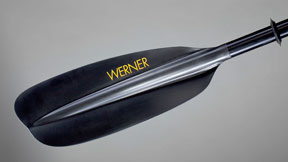Search Case Studies
End-Use Case Study
- Kayak Paddle Achieves Sought-After Aesthetics Using Carbon Fiber Recycled From Aircraft Production

Kayak paddle uses carbon fiber reclaimed from Boeing 787 Dreamliner manufacturing scrap.
Kayak paddle uses carbon fiber reclaimed from Boeing 787 Dreamliner manufacturing scrap.
Werner Paddles is committed to handcrafting the world’s finest kayak, canoe and stand-up paddles. “Pride and quality workmanship is evident every time you pick up a Werner Paddle,” and they promise their dedicated customer base of outdoor enthusiasts will “feel it with every stroke.”
Indeed, the company’s line of paddles feature blades made of carbon fiber reinforced plastic that are intended to look as good as they perform. When Werner began having aesthetic issues with the smooth, jet-black blades, they moved quickly to find a solution.
“This is an unusual application. The tough engineered compound Werner’s blades use are most often found in internal structural components where surface quality is not a priority,” explained Tim Bailey, engineering manager of Werner’s molder, KASO Plastics. But for Werner, cosmetics of the material were as important as the strength, rigidity, and other physical properties. KASO committed to find a way to deliver both for them.
Bailey and his engineering team tried upwards of a dozen different materials from several suppliers without success until they connected with RTP Company. And, what might surprise many, a recycled content material, not a virgin one, delivered the sought-after solution.
The successful material, a carbon fiber reinforced compound, was developed by RTP Company as a result of a partnership with aircraft manufacturer Boeing, who introduced them to the Aircraft Fleet Recycling Association, an emerging composite recycling network that Boeing had helped establish.
“We looked to RTP Company for high-end applications to use carbon fiber reclaimed from manufacturing scrap from our 787 Dreamliner airplane production,” said Pete George, Boeing Research and Technology Aircraft Recycling Project Manager.
“The premium, aircraft grade carbon fiber delivered the physical characteristics required at a lower fiber loading, allowing us to meet aesthetic requirements, something none of the virgin materials were able to do,” said Bailey. “In addition, it is actually a little bit easier to process, and the system cost between the recycled content carbon fiber compound and virgin alternatives is insignificant.”
Werner was delighted with the look and performance of the new paddle blades. Further, the fact that they are now manufactured using recycled content will likely be of interest to Werner’s outdoor-loving, environmentally-conscious customers.
“Werner’s kayak paddle is a great example of Boeing’s sustainable manufacturing strategy at work, where post-industrial scrap from aircraft production provides a high-performance solution for a consumer product,” said George.
Bailey noted that he and KASO have worked with RTP Company on several projects over the years, and he spoke highly of the service and support they provide, which was particularly helpful on this project.
“RTP Company’s technical support is superior, and that is very important to us. We mold highly engineered parts that are very demanding and selection of materials is critical to success,” he explained. “Many suppliers have application engineers that can help to a certain extent, but we’ve never seen anyone as knowledgeable and spot on as the people at RTP Company.”
KASO Plastics, Inc. has been a full-service custom injection molder in Vancouver, WA, since 1962. For more information, visit their website at www.kaso.com. For details on Werner Paddles go to www.wernerpaddles.com.




